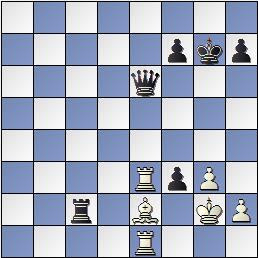I would say that it began with my discovery that Temposchlucker was actively blogging again. It was frustrating over and over again to see our failures as being unable to see the invisible, which is like a tautology: if we had seen it, it would have been visible. I had been casting about for self-improvement measures. iChess sent a promotional free video lesson from GM Daniel Naroditsky, to whom I once had the pleasure of losing a game when he was rated a mere 2256. The video captions his lecture with "GM Daniel Naroditsky, FIDE 2646". The catch line for the lecture was "How to be a Tactical Beast". He spent most of the time separating tactics into two branches - simple and complex - and then recommending resources for studying both. Then he walked through about 10 exercises from a chess server with pointers on how he would train. I came up with this outline of his resource recommendations:
Naroditsky's Recommended Tactics Resources:
- Simple Tactics
- Online
- Chess.Emrald.net - simpler tactics with time pressure
- Chess.com - tactical trainer with time pressure
- Books
- Invisible Chess Moves - Neiman, Emmanuel & Afek, Yochanan
- Understanding Chess Tactics - Weteschnik, Martin
- Online
- Complex Tactics
- Online
- ChessTempo - gold standard, but strays into complex tactics
- Books - Dvoretsky anything
- Dvoretsky's Analytical Manual
- Recognizing Your Opponents Resources
- Online
The word "Invisible" caught my eye. Yes, yes, teacher. Show me how to see the invisible. So I have embarked - as I have many times before - to try to work through a body of tactics within a book. I'm sort of looking at both of the highlighted books above. My method is to set up the position in ChessBase with the engine off, try to solve it by myself. And then read the book notes and see the engine analysis for a check. When I'm finished, perhaps I'll have a unique file that is like the e-book companion to the text. I looked at Temposchlucker's blog today and, after a break between Labor Day and Thanksgiving, he has posted about a dozen times in the past month.
It's a little early for resolutions, but I'm trying to get some modest mileage out of chess this year. Here are a few goals:
- Try to have fun
- Enjoy chess at our club
- Sharpen my tactics
- Sharpen my openings
- Play in a weekend tournament
For now, I'm staying away from performance-based accomplishments because they tend to burden me with a feeling like chess - supposedly a fun hobby - is sometimes a tedious chore. So no ratings targets and no tournament win targets. Aside from Invisible Chess Moves, Understanding Chess Tactics, and Chess Tempo, I am also looking at A.J. Roycroft's The Chess Endgame Study, Kubbel's 150 Chess Studies, Nunn's 1001 Deadly Checkmates, and Volokitin's Perfect Your Chess. I also began to look at QvR endgames again to try to get a handle on semi-perfect play.





